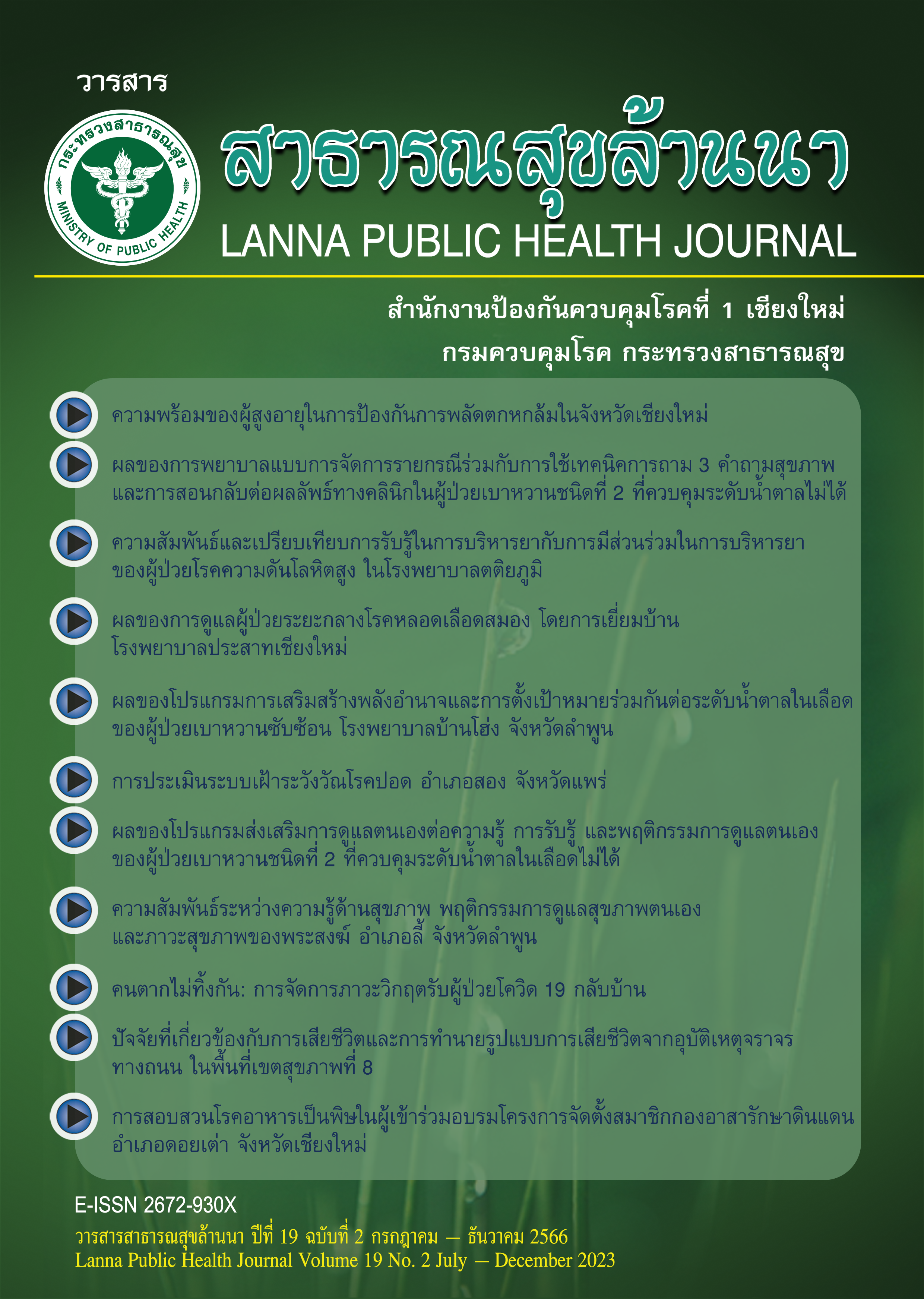ความสัมพันธ์และเปรียบเทียบการรับรู้ในการบริหารยากับการมีส่วนร่วมในการบริหารยาของผู้ป่วยโรคความดันโลหิตสูง ในโรงพยาบาลตติยภูมิ
คำสำคัญ:
การรับรู้ในการบริหารยา, การมีส่วนร่วม, การบริหารยา, โรคความดันโลหิตสูงบทคัดย่อ
การวิจัยเชิงพรรณนาแบบภาคตัดขวางนี้ มีวัตถุประสงค์เพื่อศึกษาความสัมพันธ์และเปรียบเทียบการรับรู้ในการบริหารยากับการมีส่วนร่วมในการบริหารยาของผู้ป่วยโรคความดันโลหิตสูง กลุ่มตัวอย่างเป็นผู้ป่วยที่มีอายุ 20 ปีขึ้นไปที่เข้ารับการรักษาในแผนกผู้ป่วยในโรงพยาบาลตติยภูมิ เลือกกลุ่มตัวอย่างแบบแบ่งชั้น จำนวน 202 คน ระหว่างวันที่ 15 พฤษภาคม – 15 กรกฎาคม 2566 เครื่องมือที่ใช้ในการวิจัยประกอบด้วย แบบสอบถามคุณลักษณะส่วนบุคคล การรับรู้ในการบริหารยา และการมีส่วนร่วมของผู้ป่วยความดันโลหิตสูงในการบริหารยา วิเคราะห์ข้อมูลด้วยสถิติพรรณนาและสถิติอนุมาน ได้แก่ สถิติสัมประสิทธิ์สหสัมพันธ์ของสเปียร์แมน independent sample t-test และ One - way ANOVA ผลการวิจัย พบว่า ค่าเฉลี่ยการรับรู้ในการบริหารยาอยู่ในระดับดี ค่าเฉลี่ยการมีส่วนร่วมในการบริหารยา อยู่ในระดับมากที่สุด การรับรู้ในการบริหารยากับการมีส่วนร่วมในการบริหารยาของผู้ป่วยโรคความดันโลหิตสูง มีความสัมพันธ์ทางบวก และคุณลักษณะส่วนบุคคลด้านอายุของผู้ป่วยโรคความดันโลหิตสูงที่ต่างกันมีการรับรู้ในการบริหารยาและมีส่วนร่วมในการบริหารยาแตกต่างกัน อย่างมีนัยสำคัญทางสถิติที่ระดับ 0.05 ดังนั้นการส่งเสริมให้ผู้ป่วยมีการรับรู้ในการบริหารยาและการมีส่วนร่วมในการบริหารยา อาจมีส่วนช่วยให้เกิดการจัดการความดันโลหิตสูงได้ดีขึ้น ลดความเสี่ยงของภาวะแทรกซ้อนจากโรค และคุณภาพชีวิตโดยรวมของผู้ป่วยโรคความดันโลหิตสูงดีขึ้น
เอกสารอ้างอิง
กองโรคไม่ติดต่อ กรมควบคุมโรค กระทรวงสาธารณสุข. (2566). จำนวนและอัตราตายด้วย 5 โรคไม่ติดต่อ (ปี 2560–2564) [ออนไลน์]. [สืบค้นเมื่อ 14 มกราคม 2566]; แหล่งข้อมูล: http://www.thaincd.com/2016/mission/documents-detail.php?id=14480&tid=32&gid=1-020
งานเวชระเบียนและสถิติ โรงพยาบาลมหาราชนครเชียงใหม่. (2565). รายงานสถิติประจำปี 2564. (เอกสารอัดสำเนา).
ระพินทร์ โพธิ์ศรี. (2553). สถิติเพื่อการวิจัย. กรุงเทพมหานคร: สำนักพิมพ์จุฬาลงกรณ์มหาวิทยาลัย.
วิชัย เอกพลากร, หทัยชนก พรรคเจริญ และวราภรณ์ เสถียรนพเก้า. (2564). การสำรวจสุขภาพประชาชนไทยโดยการตรวจร่างกาย ครั้งที่ 6 พ.ศ. 2562-2563 [ออนไลน์]. [สืบค้นเมื่อ 14 มกราคม 2566]; แหล่งข้อมูล: https://kb.hsri.or.th/dspace/handle/11228/5425
อารี ชีวเกษมสุข. (2564). เทคโนโลยีดิจิทัลในการดูแลผู้ป่วย: สิ่งจำเป็นสำหรับพยาบาล โรคหัวใจและทรวงอกในศตวรรษที่ 21. วารสารพยาบาลโรคหัวใจและทรวงอก, 32(1), 2-13.
Bakris, G. L., & Baliga, R. R. (Eds.). (2019). Hypertensive Heart Disease, An Issue of Heart Failure Clinics. United States of America: Elsevier.
Best, J. W., & Kahn, J. V. (1989). Research in education (6th ed.). Englewood Cliffs, New Jersey: Prentice hall.
Borzecki, A. M., Glickman, M. E., Kader, B., & Berlowitz, D. R. (2006). The effect of age on hypertension control and management. American Journal of Hypertension, 19(5), 520-527.
Burnier, M., & Egan, B. M. (2019). Adherence in hypertension: a review of prevalence, risk factors, impact, and management. Circulation Research, 124(7), 1124-1140.
Fleck, J. M. C., Pereira, R. A., Silva, A. E. B. de C., & Gimenes, F. R. E. (2021). Adherence to safety barriers in medication administration: patients’ perception. Revista Latino-Americana de Enfermagem, 29. [cite 2023 August 10]; Available from: https://www.scielo.br/j/rlae/a/PQk8YnjJrJz4rnkVMjNZnjx/
Gupta, M., Gupta, D. D., & Sood, A. (2018). Impact of awareness about hypertension on compliance to antihypertensive medication. International Journal of Basic & Clinical Pharmacology, 7(2), 244-251. [cite 2023 August 5]; Available from: https://www.researchgate.net/profile/Atal-Sood/publication/322677658_Impact_of_awareness_about_hypertension_on_compliance_to_antihypertensive_medication/links/5a8e6713aca272c56bc42ab5/Impact-of-awareness-about-hypertension-on-compliance-to-antihypertensive-medication.pdf
Horne, C. E., Stayt, L. C., Schutz, S., et al. (2023). Symptom experiences in hypertension: a mixed methods systematic review. Journal of Hypertension, 41(1), 1–16. [cite 2023 August 3]; Available from: https://pubmed.ncbi.nlm.nih.gov/36250472/
Hwang, J. I., Kim, S. W., & Chin, H. J. (2019). Patient participation in patient safety and its relationships with nurses' patient-centered care competency, teamwork, and safety climate. Asian Nursing Research, 13(2), 130-136.
Liang, L., & Shimosawa, T. (2022). Molecular Mechanisms of Na-Cl Cotransporter in Relation to Hypertension in Chronic Kidney Disease. International Journal of Molecular Sciences, 24(1), 286. [cite 2023 August 9]; Available from: https://www.mdpi.com/1422-0067/24/1/286
Muli, S., Meisinger, C., Heier, M., Thorand, B., Peters, A., & Amann, U. (2020). Prevalence, awareness, treatment, and control of hypertension in older people: results from the population-based KORA-age 1 study. BMC Public Health, 20, 1-10. [cite 2023 August 13]; Available from: https://pubmed.ncbi.nlm.nih.gov/32616004/
Neiman, A. B., Ruppar, T., Ho, M., et al. (2017). CDC grand rounds: improving medication adherence for chronic disease management—innovations and opportunities. Morbidity and Mortality Weekly Report, 66(45), 1248-1251.
Otenyo, S. O., & Kereri, D. K. (2021). Illness Perceptions and adherence to medication regimen among hypertensive patients attending a county referral hospital in Kenya. Journal of Hypertension and Management, 7(1), 59.
Pietropaoli, D., Cairo, F., Citterio, F., et al. (2023). Practical guidelines for patients with hypertension and periodontitis. High Blood Pressure & Cardiovascular Prevention, 30(1), 7-16.
Quinlan, P., Price, K. O., Magid, S. K., Lyman, S., Mandl, L. A., & Stone, P. W. (2013). The relationship among health literacy, health knowledge, and adherence to treatment in patients with rheumatoid arthritis. HSS Journal®, 9(1), 42-49.
Rivier, C., Szejko, N., Renedo, D., et al. (2022). Polygenic Susceptibility to Hypertension is Associated with Worse Cognitive Performance in Middle-Aged Persons without Dementia [online]. [cite 2023 August 15]; Available from: https://www.medrxiv.org/content/10.1101/2022.09.27.22280434v1
Shakya, R., Shrestha, S., Gautam, R., et al. (2020). Perceived Illness and Treatment Adherence to Hypertension Among Patients Attending a Tertiary Hospital in Kathmandu, Nepal. Patient Preference and Adherence, 14, 2287-2300. [cite 2023 August 23]; Available from: https://www.ncbi.nlm.nih.gov/pmc/articles/PMC7685346/
Singchungchai, P., Ingkathawornwong, T., Kritcharoen, S., Inthanon, T., Limchai-Arunreung, S., & Phanthong, U. (2009). Management of continuing education of nurse midwives by chief nurses in community hospitals in Southern Thailand. Asian Nursing Research, 3(4), 147-153. [cite 2023 August 25]; Available from: https://www.sciencedirect.com/science/article/pii/S1976131709600268
van Hoof, M., Chinchilla, K., Härmark, L., Matos, C., Inácio, P., & van Hunsel, F. (2022). Factors contributing to best practices for patient involvement in pharmacovigilance in Europe: a stakeholder analysis. Drug Safety, 45(10), 1083-1098.
World Health Organization. (2003). Adherence to long-term therapies: evidence for action. Switzerland: World Health Organization.
World Health Organization Regional Office for Europe. (2013). Exploring patient participation in reducing health-care-related safety risks. Copenhagen, Denmark: World Health Organization Regional Office for Europe.
World Health Organization. (2023a). Hypertension [online]. [cite 2023 August 15]; Available from: https://www.who.int/health-topics/hypertension#tab=tab_1
World Health Organization. (2023b). Noncommunicable diseases [online]. [cite 2023 August 15]; Available from: https://www.who.int/news-room/fact-sheets/detail/noncommunicable-diseases








